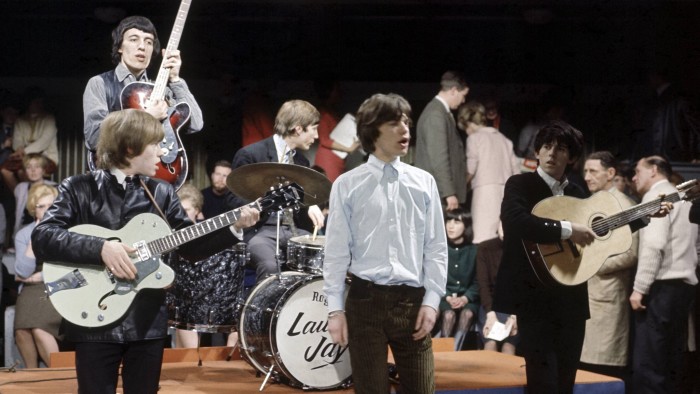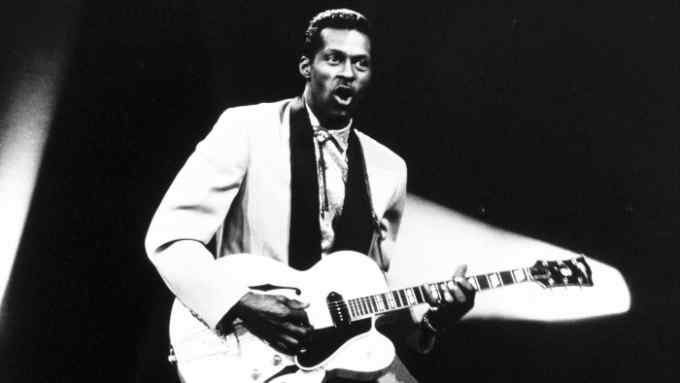How Not Fade Away inspired a young Mick Jagger to form his own band

Simply sign up to the Life & Arts myFT Digest -- delivered directly to your inbox.
Bomp, ba-bomp, ba-bomp, ba-bomp-bomp. There was a thrilling voltage to the new beat that went rattling through 14-year-old Mick Jagger, seated at his first rock concert in the Woolwich Granada, London, in March 1958. On stage, 21-year-old Buddy Holly and The Crickets were thumping out “Not Fade Away”, the B-side to their 1957 hit single “Oh Boy!” The Texan band’s sheer volume was a revelation to Jagger: Holly and The Crickets had followed a 28-piece dance band on to the stage and, thanks to a “giant amplifier” (actually a 50-watt Fender Bassman), managed to sound three times as loud. It was young Jagger’s first encounter with the “juba” beat. With its Yoruba drumming, kept alive through plantation slave stomping and body-patting, the rhythm had been popularised by Mississippi-born, Chicago-bred musician Bo Diddley in the mid-1950s.
This restless innovator took up the guitar aged 12 and never stopped tinkering with it. He electrified it with parts of an old radio and phonograph to attract attention while busking and filled it with old toys to make it rattle. He also upcycled the floats from old toilet cisterns as maracas and was one of the first R & B stars to make prominent use of female musicians in his band.
But Diddley’s thick fingers made it impossible for him to play complicated lead parts like his blues heroes, so he slammed the focus on to rhythm. “Muddy [Waters] and Chuck were close to the straight electric blues,” says Keith Richards. “But Bo was fascinatingly on the edge. There was something African going on in there. His style was outrageous, suggesting that the kind of music we loved didn’t just come from Mississippi. It was coming from somewhere else.”
Buddy Holly felt the same. Although “race music” wasn’t considered appropriate listening for Southern Baptist boys, he fell for R & B as a teen and covered Bo Diddley’s song “Bo Diddley” in 1956.
“Not Fade Away” came about when Crickets drummer JI Allison improvised the Bo Diddley beat (technically known as a “3-2 clave”) in the studio on a cardboard box, with Holly adding melody and lyrics.
With Holly’s boyish delivery, backed by the Crickets’ cute “bop bops”, the original song was playful. But the Stones’ 1964 cover — their first US single — brought out the stalkerish menace in Holly’s lyrics: “I’m gonna tell you how it’s gonna be,” snarled Jagger. “You’re gonna give your love to me.” Richards flayed the riff raw. Stones Bassist Bill Wyman says that while Holly had played the Diddley beat “lightly”, the English band slammed the rhythm “right up front”. The Stones’ boozy recording session featured Gene Pitney on backing vocals and Phil Spector (rattling a 50 cent piece in a cognac bottle) on percussion.
Since then, the song has been covered (mostly live) every which way by a Who’s Who of rock’n’roll, including The Beatles (peppy), The Byrds (copying Brian Jones’ harmonica), Bob Dylan (countrified), Bruce Springsteen (roared a cappella against a drum beat), The Grateful Dead (trippy jam), Patti Smith (country punk), U2 (mixed into their Diddley-beat hit “Desire”), Simon & Garfunkel (flavoured with more modern African beats), Paul Weller (shouty), James Taylor (with accordion), Stevie Nicks (poppy), Queen (drifting comically out of tune) and Jack White (brooding). Sheryl Crow sang it to sell Revlon hair dye in 2007.
Most recently Florence + The Machine gave the song a soulful voodoo twist in a version recorded with Cajun musicians in New Orleans in 2010. With her face painted as a skull, Florence Welch yowls out Holly’s fragmented, modernist lines as if to the ghost of the singer who died in a plane crash, aged 22. “A-well, a-love that’s love — not fade away . . . A-hoooo!”
Meanwhile, the man who gave his name to the beat died aged 79 in 2008. His last interview with Rolling Stone in 2005 found him still tinkering, taping Velcro to his guitar picks to hold them in place.

Comments